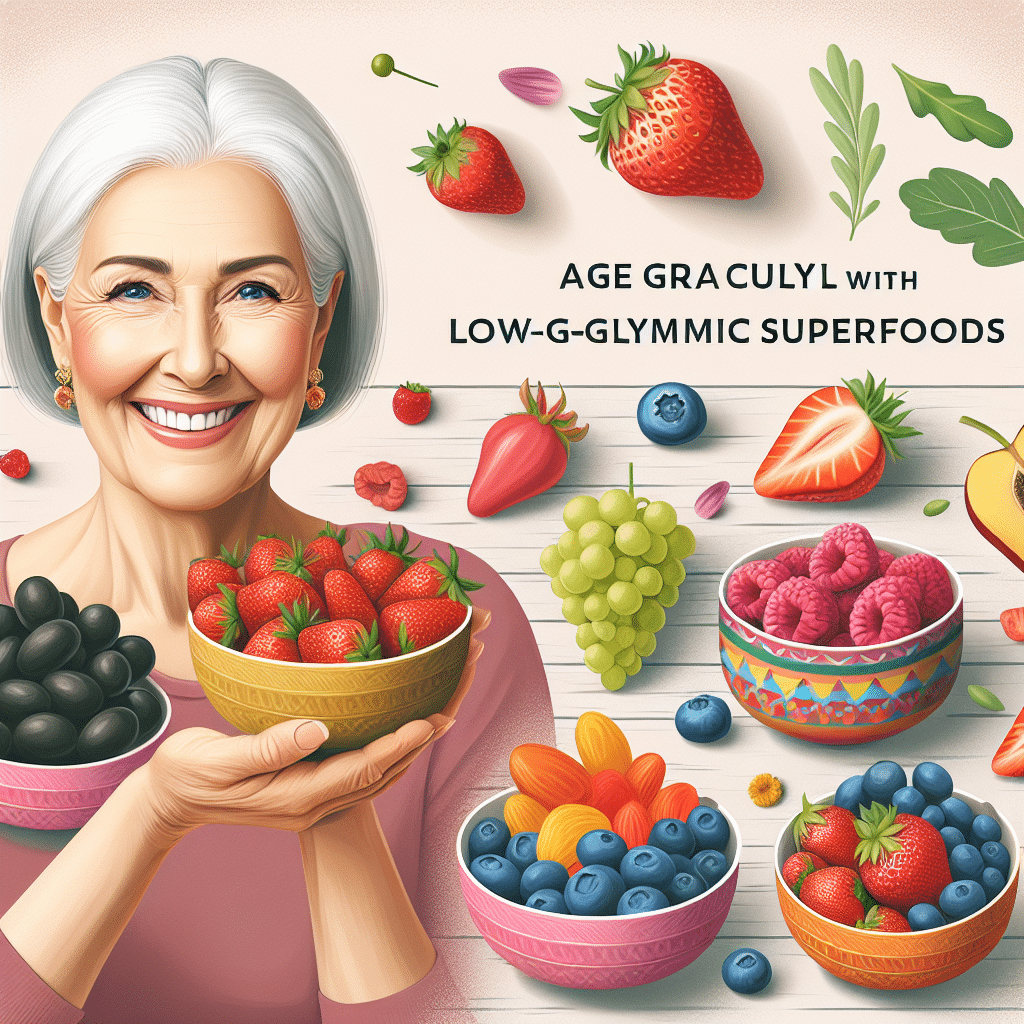Age Gracefully with Low-Glycemic Superfoods
-
Table of Contents
- Age Gracefully with Low-Glycemic Superfoods: A Nutritional Guide
- Understanding the Glycemic Index
- The Role of Low-Glycemic Superfoods in Aging
- Top Low-Glycemic Superfoods for Healthy Aging
- Implementing Low-Glycemic Superfoods into Your Diet
- Case Studies and Statistics: The Impact of Low-GI Diets on Aging
- Conclusion: Embrace Low-Glycemic Superfoods for Longevity
- Enhance Your Diet with ETprotein’s High-Quality Protein Products
Age Gracefully with Low-Glycemic Superfoods: A Nutritional Guide

Aging is an inevitable process, but the way we age can be significantly influenced by our lifestyle choices, particularly our diet. Incorporating low-glycemic superfoods into our daily routine can help us age gracefully, maintaining vitality and health. This article explores the benefits of these superfoods and how they can be integrated into a balanced diet for optimal aging.
Understanding the Glycemic Index
The glycemic index (GI) is a measure of how quickly foods containing carbohydrates raise blood sugar levels. Foods with a high GI are rapidly digested and absorbed, causing a swift spike in blood sugar and insulin levels. Conversely, low-GI foods are digested and absorbed at a slower rate, leading to a gradual rise in blood sugar and insulin.
Consistently high blood sugar levels can lead to insulin resistance, a precursor to type 2 diabetes, and can also contribute to inflammation, which is associated with various age-related diseases. Therefore, a low-GI diet is not only beneficial for managing diabetes but also for promoting longevity and reducing the risk of chronic diseases.
The Role of Low-Glycemic Superfoods in Aging
Low-glycemic superfoods are nutrient-dense foods that have a minimal impact on blood sugar levels. They are rich in vitamins, minerals, antioxidants, and fiber, which collectively support healthy aging. Here are some of the ways these superfoods can contribute to a graceful aging process:
- Reducing Inflammation: Chronic inflammation is linked to many age-related diseases. Antioxidants found in low-GI foods help neutralize free radicals and reduce inflammation.
- Supporting Heart Health: Many low-GI foods are high in fiber and healthy fats, which are known to support cardiovascular health.
- Enhancing Brain Function: Foods with a low GI often contain omega-3 fatty acids and other nutrients that are crucial for cognitive health.
- Maintaining Healthy Weight: Low-GI foods can help regulate appetite and reduce the likelihood of overeating, which is important for weight management as metabolism slows with age.
Top Low-Glycemic Superfoods for Healthy Aging
Integrating a variety of low-GI superfoods into your diet can help you reap the benefits of a nutrient-rich, balanced diet. Here are some top choices:
- Leafy Greens: Spinach, kale, and other leafy greens are low in calories and high in vitamins and minerals, including antioxidants that protect against cellular damage.
- Whole Grains: Quinoa, barley, and rolled oats have a lower GI than white bread and rice, providing sustained energy and fiber for digestive health.
- Nuts and Seeds: Almonds, chia seeds, and flaxseeds are not only low-GI but also rich in healthy fats and protein, which are essential for maintaining muscle mass and joint health.
- Legumes: Lentils, chickpeas, and black beans are excellent plant-based protein sources that help manage blood sugar levels and are packed with fiber.
- Berries: Blueberries, strawberries, and other berries are low in sugar and high in antioxidants, which are beneficial for skin health and may reduce the risk of certain cancers.
Implementing Low-Glycemic Superfoods into Your Diet
Adopting a diet rich in low-GI superfoods doesn’t have to be challenging. Here are some practical tips for incorporating these foods into your daily meals:
- Start your day with a bowl of oatmeal topped with berries and nuts instead of sugary cereals.
- Choose whole-grain bread and pasta over their white counterparts.
- Snack on a handful of almonds or make a smoothie with spinach and chia seeds.
- Include a serving of legumes in your meals several times a week.
- Opt for sweet potatoes instead of white potatoes for a lower-GI alternative.
Case Studies and Statistics: The Impact of Low-GI Diets on Aging
Research has consistently shown the benefits of low-GI diets for health and longevity. For instance, a study published in the American Journal of Clinical Nutrition found that individuals who consumed a low-GI diet had a reduced risk of chronic diseases such as heart disease and type 2 diabetes. Another study in the Journal of Nutrition, Health & Aging demonstrated that older adults who adhered to a low-GI diet had improved cognitive function compared to those who consumed high-GI foods.
Statistics also support the adoption of a low-GI diet for healthy aging. According to the World Health Organization, diets that are low in refined sugars and high in whole grains and fiber are associated with a lower risk of non-communicable diseases, which are the leading cause of death in older populations.
Conclusion: Embrace Low-Glycemic Superfoods for Longevity
Embracing low-glycemic superfoods is a powerful strategy for aging gracefully. By choosing foods that support stable blood sugar levels, reduce inflammation, and provide essential nutrients, we can promote overall health and well-being as we age. Incorporating a variety of these superfoods into a balanced diet can lead to improved energy levels, cognitive function, and a reduced risk of chronic diseases.
Enhance Your Diet with ETprotein’s High-Quality Protein Products
For those looking to complement their diet with high-quality protein sources, ETprotein offers a range of organic bulk vegan proteins that align with the principles of low-GI, healthy aging. Their products, including organic rice protein, pea protein, and various seed proteins, are non-GMO, allergen-free, and boast a high purity of L-(+)-Ergothioneine (EGT), an amino acid known for its antioxidant properties.
ETprotein’s offerings are ideal for individuals seeking to maintain muscle mass, support joint health, and enhance overall vitality through their golden years. By integrating ETprotein’s products into your diet, you can ensure that you’re getting the protein you need without compromising on the low-GI benefits that are so crucial for aging gracefully.
About ETprotein:
ETprotein, a reputable protein and L-(+)-Ergothioneine (EGT) Chinese factory manufacturer and supplier, is renowned for producing, stocking, exporting, and delivering the highest quality organic bulk vegan proteins and L-(+)-Ergothioneine. They include Organic rice protein, clear rice protein, pea protein, clear pea protein, watermelon seed protein, pumpkin seed protein, sunflower seed protein, mung bean protein, peanut protein, and L-(+)-Ergothioneine EGT Pharmaceutical grade, L-(+)-Ergothioneine EGT food grade, L-(+)-Ergothioneine EGT cosmetic grade, L-(+)-Ergothioneine EGT reference grade and L-(+)-Ergothioneine EGT standard. Their offerings, characterized by a neutral taste, non-GMO, allergen-free attributes, with L-(+)-Ergothioneine purity over 98%, 99%, cater to a diverse range of industries. They serve nutraceutical, pharmaceutical, cosmeceutical, veterinary, as well as food and beverage finished product distributors, traders, and manufacturers across Europe, USA, Canada, Australia, Thailand, Japan, Korea, Brazil, and Chile, among others.
ETprotein specialization includes exporting and delivering tailor-made protein powder and finished nutritional supplements. Their extensive product range covers sectors like Food and Beverage, Sports Nutrition, Weight Management, Dietary Supplements, Health and Wellness Products, and Infant Formula, ensuring comprehensive solutions to meet all your protein needs.
As a trusted company by leading global food and beverage brands and Fortune 500 companies, ETprotein reinforces China’s reputation in the global arena. For more information or to sample their products, please contact them and email sales(at)ETprotein.com today.












